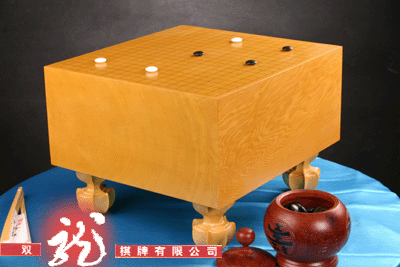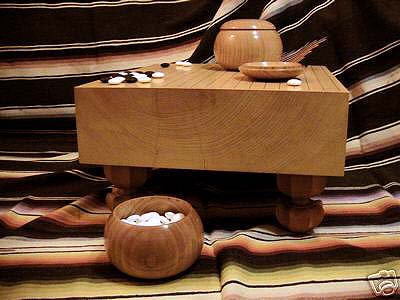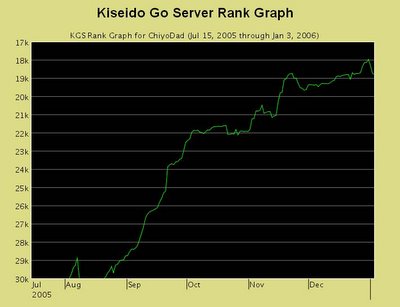In my previous post's
comment section, reader JMP noted how Janice Kim's first three volumes of Learn To Play Go had a lot of breadth but lacked depth.
Please note that I consider Ms. Kim's books to be excellent learning materials (else I would not have recommended Vol. 1 in my
2005 Holiday Gift Guide); I just disagree with that text box that implies that a typical reader would be 12k in strength after reading the first three volumes and having
"a little experience". In my humble opinion, 25k-to-20k (as measured on CyberOro, IGS or KGS) would be a more realistic measure of achieved strength.
Anyway, today I'd like to give you my first impressions of three other books that are narrow in scope but go
very deep.
Dictionary of Basic Joseki: Volumes 1-3
Ever a sucker for bargains, I bought all three volumes of
Yoshio Ishida's
Dictionary of Basic Joseki at
Kinokuniya back in late September. Each was priced at just $12 (40% off their normal price of $20). Back then, I had absolutely no idea how or even if I would use them.
In fact, my first thought was,
"These must be underpriced because nobody wants to buy them."Well, I'm finding a
lot of use for them now. Ishida does a wonderfully in-depth job of explaining joseki, including:
- What variations can arise
- How some variations may be used from a whole-board perspective
- Why one variation may be preferred over the other and why you may not want to play the variation or the joseki
- Whether one may lose sente by following a variation and, in some cases, how to retain sente
- Which variations are slack or aggressive
- Why the stones must be played
- What critical points for either color arise as the shapes evolve
- What weaknesses exist that can be exploited
- What countermeasures and tesuji can be applied to the shapes
I've only read about 30% of his write-ups on two common joseki (that's less than 1% of the total content of all three volumes) but I'm finding his writings to be very helpful in the study of shape, life-and-death and tesuji.
I've been using the dictionaries in conjuction with my other Go books; almost always taking one the basic books
and one of the dictionary volumes with me when I sit down for a good read. On more than one occasion, I wound-up spending more of my time reading the dictionary. I get caught-up wondering what develops with each variation and the
"why" behind each move.
Regular Go books will often mention a simple variation of a joseki and (sometimes) note just a few critical points to watch out for. As a result, you wind-up lost or stupefied when your opponent chooses to not follow the variation that has been presented.
Thrice in actual games, Ishida's write-ups helped me immediately recognize when my opponents' departures created exploitable openings; giving insight on where to play, in what direction, and what tesuji can be used. This has given me more confidence in applying (and in choosing not to apply) the two joseki that I've been studying to date.
Overall, the books impress me as good references when you truly want to understand what make these moves
optimal and
time-tested. I think that qualifies them for the
study (as opposed to memorization) of joseki, and helps guard against "joseki poisoning" which
Go Seigen warns of in his book,
A Way of Play for the 21st Century.
Certainly, joseki are only part of one's arsenal. Whether they are worth studying in the lower kyus is the subject of much debate; but
Toshiro Kageyama himself, 7P and author of the bestseller
Lessons In The Fundamentals of Go
, considered the proper study of joseki as
"one of the first steps in getting stronger".
For me, joseki are an interesting area to explore and a great jumping point to other areas of Go; particularly when using Ishida's dictionary. Perhaps they may not be the express route to shodan (tesuji probably claims that distinction), but they certainly qualify for the scenic route.
My impulsive $36 purchase is looking like an even better bargain today. I don't know if Kinokuniya is still selling these at just $12 each but keep your eye out for them if you should visit
one of their bookstores.
A
free alternative to consider would be
Kogo's Joseki Dictionary. This is a large SGF which can be read using a tool like
Drago (my preferred SGF utility). I didn't find it as thorough in explaining the
whys and
hows of each joseki and it notably lacks the enlightening quality of Ishida's writing; but, for those of you on a budget, it's an option you may not want to pass-up.
FridgeGo
I learned that
Fridgeplay in the UK had released a
9x9 magnetic Go board suitable for refrigerator surface play (or anywhere else you can stick it to). My understanding is that it was developed with the assistance of the
British Go Association and instructor
Peter Wendes. The cost is about £10 (US$18).
Fridgeplay sells its products in the US but I haven't seen this set anywhere locally. You can find them sometimes on eBay but you may also be able to
order them directly from Mr. Wendes.
I'm sure the 9x9 grid will be satisfying for some. It's ideal for introducing newcomers to the game as can be seen in most of the workshop photos from
ZenMachine (turn down your audio, this site has background music).
For myself, I only wish that they had expanded the grid to 19x19.

























